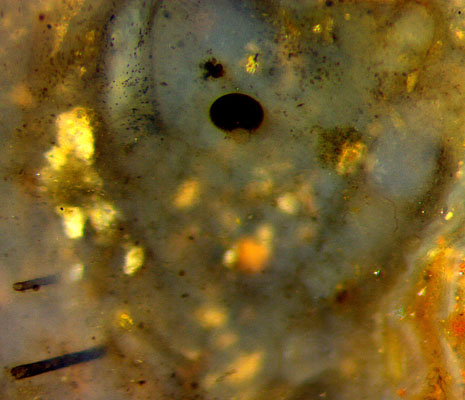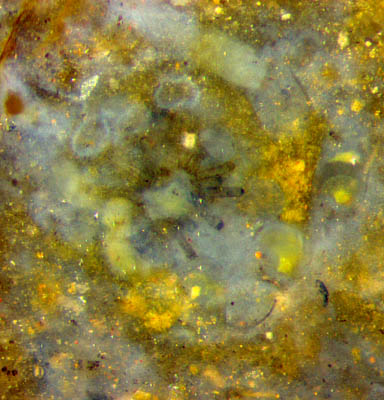Questionable Devonian
charophyte Palaeonitella
The apparent scarcity of
Palaeonitella
gyrogonites has
been puzzling, all the more so since the fruits with the
characteristic spiral aspect are well known as
index fossils from almost
every one of the numerous fossil and extant species
of stonewort-like charophyte algae.
It took the authors [1] some effort to find a
small number of gyrogonites,
previously not known in
the Rhynie chert, however
poorly
preserved and detached. They made use of them for their
emended diagnosis [1] of
Palaeonitella cranii
[2], including a reconstruction.
The statement that "examples of the reproductive organs of Palaeonitella cranii
are very rare" ([1] p.446) may explain the fact that no
gyrogonites have been found in own Rhynie chert samples but there is a
more interesting explanation:
The discovery of a peculiar
charophyte with a quite
different type of oogonia (see Rhynie Chert
News
73,
89,
90), not
seen before for possible reasons listed below, gave rise to
suspicion: Some or most of the
specimens assigned to Palaeonitella
might belong to the new charophyte species lacking gyrogonites. Once
raised, the suspicion may even encroach upon the emended
diagnosis [1] based on poorly preserved
gyrogonites.
Putting
the question aside how distinctly the spiral pattern should be seen in
order to serve as evidence of a gyrogonite, let us turn to the much
simpler case of capsules without any spiral pattern at all, as those in
the three
contributions listed above, and in Fig.1 below.
There, the oogonia are completely smooth,
ellipsoidal to bean-shaped, and borne on long slender stalks. They may
be so clearly visible that one wonders why they have not been seen
all the time.
Here are some possible answers:
- Well-preserved charophyte (stonewort) fossils with smooth
oogonia had not been available before.
- Possibly they had been seen but not recognized as such and
hence not published.
- If less well preserved, the capsules are easily mistaken
for branch cross-sections or fungus vesicles of similar sizes.
- If very poorly preserved, the capsules are not noticed at
all unless specially looked for.



Fig.1: Oogonium, apparently bean-shaped,
with evidently smooth
surface, attachment site below, within a poorly visible basket
made of a whorl of upward-bent charophyte
branches. Image width 1.2mm.
Fig.2: Partially decayed
charophyte "flower", top view with cross-sections of branches and
oogonia. Image width 1.2mm.
Fig.3: Largely decayed charophyte "flower", top view with thin
stalks on a central column. Image
width 1mm.
Figs.1-3
are to show that it would be difficult to recognize the smooth oogonia
in the chert if there were not the much better preserved
specimens in the above-mentioned contributions for comparison. One
would not expect the black object in Fig.1 to be one of more than a
dozen similar ones normally present at the same whorl but not seen here
for reasons unknown. (Unrelated but interesting: The straight tubes
below left belong to an enigmatic nematophyte.)
The cross-sections
of oogonia and branches can often but not always be distinguished by
their
sizes, as in Fig.2. Such distinction is less clear in Fig.3. Clearly
seen in Fig.3 are more than a dozen stalks emerging from the central
column, left there after the oogonia had been shed. (See oogonia on
stalks in Rhynie Chert
News 73,
Figs.2,4,5.)
Samples:
Rh6/102 (0.03kg) found by S.
Weiss in 2003, "alga flower" recognized in 2016: Fig.1.
Rh9/93 (0.55kg) found by S.
Weiss in 2011, "alga flower" recognized in 2015, then cut into 10 parts, here Parts 1 (Fig.2) and 6 (Fig.3);
The problem with stoneworts in the Rhynie chert has turned out to be
a complex and hence interesting one:
According to [1], the
hitherto described specimens [1,2], although never seen with adhering
gyrogonites, are thought to belong to Palaeonitella cranii
in the sense of the emended
diagnosis [1] involving gyrogonites
at whorls (as with
extant Tolypella).
Own finds of stoneworts
distinguished by "alga flowers" on branch ends with a multitude of
smooth oogonia have been
interpreted as a peculiar
alga differing largely from any known stonewort,
thus deserving a special place on the phylogenetic tree. This species
must be a relic from times before the
number of oogonia in the "alga flower" had reduced to only one and
the
surrounding branches of the whorl had closely wrapped around the only
left oogonium in a spiral way to form the gyrogonite in the course of
evolution. Therefore, Palaeonitella
cranii [1] and
all other algae with gyrogonites are advanced with respect to
the Peculiar Alga.
It is thinkable that
some or most alleged Palaeonitella
finds represent
this Peculiar
Alga at a juvenile stage, without an "alga flower" at the
top. This
applies also to stonewort-like fossils in own samples which had been
described in Rhynie Chert
News 10,
74, because of their
similarity with Palaeonitella [2], under that familiar name.
H.-J.
Weiss 2019
[1] R.
Kelman, M. Feist, N.H. Trewin, H. Hass: Charophyte algae
from the Rhynie chert.
Trans. Roy. Soc. Edinburgh 94
Part 4 (2004 for 2003), 445-455.
[2] R.
Kidston, W.H. Lang: On Old Red Sandstone plants showing
structure ... Part V...
Trans. Roy. Soc. Edinburgh 52
(1921), 855-902.
 |
 |
138 |






